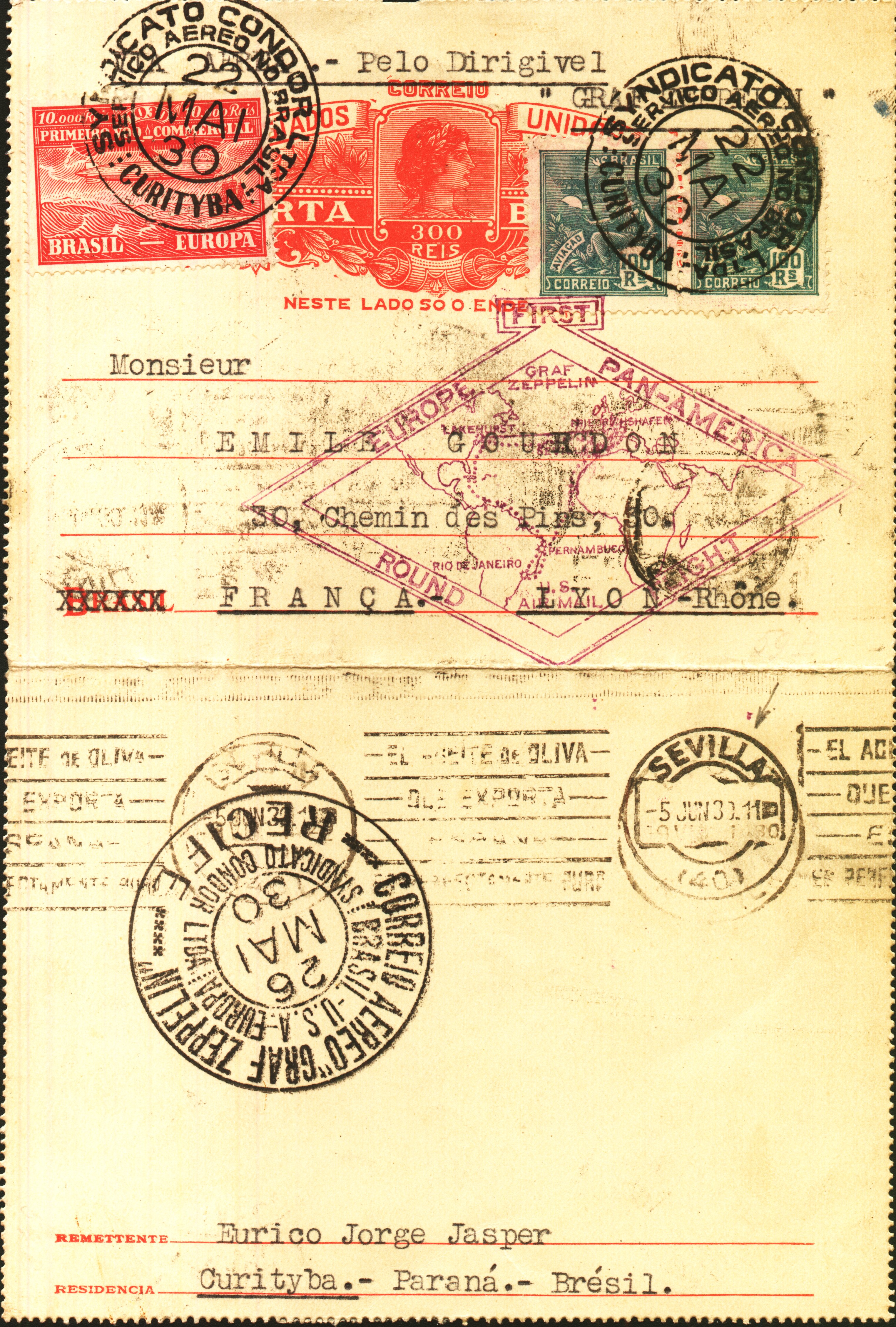|
© Dr. Artur Knoth |
Brazilian Philately: The Pan Am Zeppelin Flight of 1930 |
French Destinations on the Pan-Am Flight
Even more than 75 years after the Zeppelin's 1930 Pan-Am flight, some aspects still remain unclear. The subject of this research note (a condensed version was originally published in the Airpost Journal/1/) may seem to be trivial to some, if not most, but for me it is an interesting aspect and a detail that might be cleared up with more examples that only other collectors can supply. Although my specialty is that of the Brazilian covers on this flight, my call goes out to all collectors you have covers from this flight that were sent to French addresses. Mail to France takes on a special aspect when one considers that France didn't even allow the Zeppelin overflight rights let alone participate otherwise /2/.
At least on paper, the distribution of the mail destined for Europe and beyond seems to be quite straight forward. In any case, Spanish mail was off-loaded in Seville and the rest went to Friedrichshafen to be forwarded from there. A single cover addressed to South Africa seems to have also been off-loaded in Seville and sent south from there. Logically this makes sense. And that all the rest of the European mail went to Germany doesn't necessarily always make sense. Why wasn't the mail to Portugal unloaded in Seville instead of in Germany? The single cover to Portugal in my collection also went via Germany.
Yet, the case of France demonstrates that not everything is that easy. In terms of my own collection and logs I've kept of auctions, I've examined covers with Brazilian frankings sent to French addresses. Most were off-loaded in Seville, but a very few seem to have been delivered via Friedrichshafen. And there seems to be no real logic to the case of covers delivered via Germany except that they are addressed to Paris. But even some Parisian letters went via Seville. Up to now, restricted to Brazilian franking, I've seen at most about a dozen covers, statistical seen very little, but about 80% or more having left the Zeppelin in Seville. The „Seville“ mail is easily identified by the „olive oil export“ machine arrival cancellation applied on the back of the mail unloaded there (Fig. 1).
![]() Figure 1: Typical „olive oil“ machine cancel, usually the 5th
of June,1930
Figure 1: Typical „olive oil“ machine cancel, usually the 5th
of June,1930
This „French“ mail came from allover the Brazilian philatelic region on this flight. Many letters originated in Rio de Janeiro (Fig. 2 to 4), although one had a routing instruction for Seville (Fig. 4). Another letter was sent from Recife (Fig. 5) but using the more or less emergency stamp 5$000/1$300 as Condor started running out of the other 5$000 issues. Then there is a letter card out of Curitiba and a metered cover to Lyon (Fig. 6 and 7). And finally a letter that was sent from Buenos Aires via Condor (Fig. 8), canceled in Rio, to Pessac a city in the Gironde and near Bordeaux.
|
|
|
|
|
|
|
|
 Figure 6: Letter card out of Curitiba to Lyon. Note the shadowy
Lyon cancels right on top of the Seville cancels.
Figure 6: Letter card out of Curitiba to Lyon. Note the shadowy
Lyon cancels right on top of the Seville cancels.
The next Lyon cover, a rarely seen metered version, the back clearing demonstrates how the Lyon machine cancel can be almost synchronous with the Seville circles.
That brings us to the examples of those few covers relayed to France via Frieddrichshafen. One of the most interesting is the case of the Henot letters. Between my collection (Fig. 9) and a lot that appeared in Ebay, I know of two, very similar, letters addressed to a Mr. Henot, both to the exact same address, yet one went via Seville the other over Germany. The appearance of both leads one to assume that both letters entered the mail stream together. Nor does the one via Seville have a special routing request, i. e. Spain.
The next example is a case where someone was doing a business partner/collector a favor. Franking with a complete set of the Zeppelin stamps. The different Friedrichshafen cancel on the back means probably that the letters, Fig. 9 and 10, were not in the same batch/mail sack? Are all the covers that went to Friedrichshafen, all a sort of last minute, left over covers that were thrown together into a few sacks that went direct to Germany?
Thus, I would like to enlist the help of my fellow collectors, and ask them to look at any and all covers addressed to France, with whatever franking, for the 1930 Pan-Am flight. Perhaps a better statistical foundation could lead to more information of how this situation with the French mail occurred and a possible explanation
References:
/1/ Dr. Artur Knoth: French Destinations on the 1930 Zeppelin Pan-Am Flight; Airpost Journal 74(10), 431(October 2003)
/2/ John Duggan: A Hindenburg Miscellany; Zeppelin 9(2), 17 (June 2006)